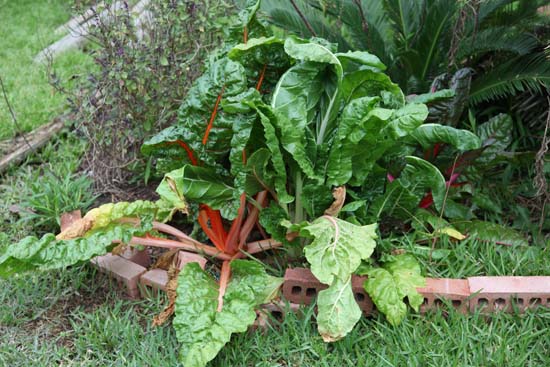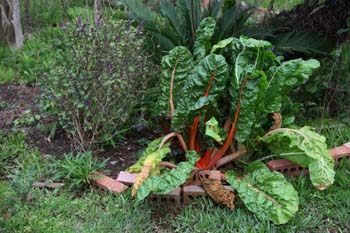Swiss Chard: Nutritious Greens or Ornamental for the Flower Garden?
Loaded with Polyphenol Antioxidants, Vitamins, and it’s a Blood Sugar Stabilizer
Copyright © Vicki Riviera; all Rights Reserved; content may not be copied, rewritten, or republished without written permission; Posted February 27, 2012


Actually, Swiss chard is both a vitamin-packed green and a beautiful ornamental. If you live in the hot south and want a steady supply of greens for your table, this might be your best choice. When the weather turns up the heat, greens like kale and lettuce will fade, but chard keeps chugging along.
And as a bonus, when the weather turns cold it can tolerate temperatures down into the 20s. The beautiful examples in the photo above survived two hard freezes this past winter. Now that spring is here they are as healthy as ever.
Planting and Caring for Chard
Like most other plants in your kitchen garden, greens can be either planted from seed or small plants sold at you local nursery. Actually, since this particular plant is from the beet family, you can plant beets and get the same nutritional value from those leaves
This plant is so hearty that even non-green-thumb gardeners will find cultivation virtually foolproof. I like to apply a high-quality organic fertilizer every month and do a foliar feeding with Garrett Juice every two weeks or so along with the rest of my garden.
As I said above, this plant will give you a steady supply of greens year round. As you remove individual leaves, the plants will put out new growth. All you have to do is estimate how often you will eat it, and from that, decide how many plants to put in.
There are many ways to incorporate this green into your diet. You can add it to salads and soups, or run it through your blender. One of my favorite ways in this easy Swiss chard recipe.
Packed with Polyphenol Antioxidants
Chard has been shown to contain a minimum of thirteen important polyphenol antioxidants. One of these is kaempferol; this is cardioprotective flavonoid that's also found in broccoli. But another important flavonoid in the leaves is syringic acid.
This acid has been shown in recent research to do an excellent job of regulating blood sugar. This works by inhibiting the activity of an enzyme know as alpha-glucosidase. When this happens, fewer carbohydrates are broken down into simple sugars. The end result? Your blood sugar stays steadier.
Packed with Nutrition and Flavor
 As all you dedicated foodies know, there is a reason we are encouraged to eat many different colors of produce.
As all you dedicated foodies know, there is a reason we are encouraged to eat many different colors of produce.
This is because different colors indicate different nutrients. Just look at those colors—deep green, dark reds, vibrant oranges; it’s a rainbow of good things.
Think your on-a-day vitamin is packed? Have a look at the RDA this green offers in a one cup serving according to The World’s Healthiest Foods:
- Vitamin K: 715.9%
- Vitamin A: 214.3%
- Vitamin C: 52.5%
- Magnesium: 37.6%
- Manganese: 28.9%
- Potassium: 27.4%
- Iron: 22%
- Vitamin E: 16.5%
- Drum roll please, Calories: 1%
Do you have any favorite Swiss chard recipes or growing tips? Please share them with our readers in the comment section below!
References:
More Organic Gardening and Food Articles
- The Organic Method of Planting a Tree
- Build a Raised Bed Vegetable Garden
- Best Fruit Tree Choices for the Texas Gulf Coast and the Southern US
- Organic Apple Sauce Recipe
Website © 2012 Kelly Smith; all rights reserved; content may not be copied, rewritten, or republished without written permission. Webmaster’s Google profile